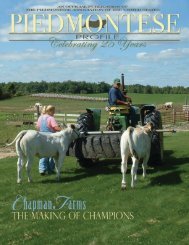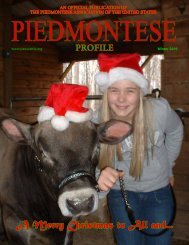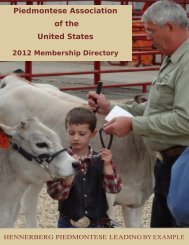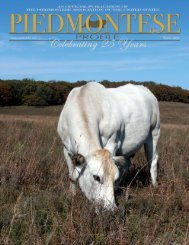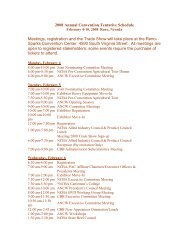I edmontese - Piedmontese Association of the United States
I edmontese - Piedmontese Association of the United States
I edmontese - Piedmontese Association of the United States
Create successful ePaper yourself
Turn your PDF publications into a flip-book with our unique Google optimized e-Paper software.
COW/CALF INSIDER<br />
PIEDMONTESE | PROFILE<br />
COOL Considerations for<br />
Cow-Calf and Stocker Producers<br />
Derrell S. Peel, OSU Livestock Marketing Specialist<br />
Mandatory Country <strong>of</strong> Origin Labeling will take effect<br />
on September 30, 2008. There are specific rules on <strong>the</strong><br />
definition <strong>of</strong> retailers and on processed foods (which<br />
are exempted) and on food service establishments<br />
(which are also exempted) but in general, beef sold in<br />
retail markets must bear a label or notice to consumers<br />
about <strong>the</strong> origin <strong>of</strong> <strong>the</strong> beef. Only beef from animals<br />
born, raised and slaughtered in <strong>the</strong> U.S. may be labeled<br />
Product <strong>of</strong> U.S.A. O<strong>the</strong>r product must identify <strong>the</strong><br />
country or countries <strong>of</strong> origin, which might include <strong>the</strong><br />
U.S. and o<strong>the</strong>r countries. USDA-AMS has indicated that<br />
<strong>the</strong>y will use <strong>the</strong> first six months to help retailers and<br />
suppliers come into compliance with <strong>the</strong> law.<br />
Meat packers are considered <strong>the</strong> originators <strong>of</strong> <strong>the</strong><br />
origin claim but <strong>the</strong> interim final rule indicates that <strong>the</strong><br />
slaughter facility “must possess or have legal access to<br />
records that are necessary to substantiate <strong>the</strong> origin<br />
claim.” “A producer affidavit shall be considered<br />
acceptable evidence provided it is made by someone<br />
having first-hand knowledge <strong>of</strong> <strong>the</strong> origin <strong>of</strong> <strong>the</strong> animals<br />
and identifies <strong>the</strong> animals unique to <strong>the</strong> transaction.”<br />
Records maintained in <strong>the</strong> course <strong>of</strong> normal conduct<br />
<strong>of</strong> business may serve as verification. Animals that are<br />
part <strong>of</strong> a NAIS compliant or o<strong>the</strong>r recognized <strong>of</strong>ficial<br />
identification system may use <strong>the</strong> animal ID to verify<br />
origin claims.<br />
Cow-calf producers can use a wide variety <strong>of</strong> herd or<br />
calving records, feed purchases, animal health or vaccine<br />
purchases to document <strong>the</strong> normal level <strong>of</strong> production<br />
that would verify <strong>the</strong> origin <strong>of</strong> calves <strong>the</strong>y sell. Producers<br />
should be prepared to provide an affidavit to <strong>the</strong> buyer<br />
stating <strong>the</strong> origin and <strong>the</strong> existence <strong>of</strong> such records.<br />
Producers should keep a copy <strong>of</strong> <strong>the</strong> affidavit noting <strong>the</strong><br />
buyer and/or <strong>the</strong> date and location <strong>of</strong> <strong>the</strong> sale. COOL<br />
also covers meat from breeding animals which means<br />
that producers should keep records <strong>of</strong> raised animals<br />
used for breeding and should request an affidavit for any<br />
purchased cows or bulls.<br />
All animals in <strong>the</strong> U.S. as <strong>of</strong> July 15, 2008 are considered<br />
to be U.S. origin. It is important for cow-calf producers<br />
to document herd size and composition for <strong>the</strong>se animals<br />
that are “grandfa<strong>the</strong>red” in under this date. Young cows<br />
that may not be sold for several years may need this<br />
documentation to verify <strong>the</strong> status as <strong>of</strong> July 15, 2008.<br />
Stocker producers, like o<strong>the</strong>r suppliers, must “maintain<br />
records to establish and identify <strong>the</strong> immediate previous<br />
source and <strong>the</strong> immediate subsequent recipient.”<br />
Commingling <strong>of</strong> animals creates a challenge but AMS<br />
has indicated that as long as a producer has records <strong>of</strong><br />
purchases and sales that reasonably account for total<br />
animal sales, individual animals or subsets <strong>of</strong> animals<br />
need not be traced back to specific purchase group(s).<br />
Thus, animals purchased from a variety <strong>of</strong> sources<br />
arriving with affidavits that show that animals all have<br />
<strong>the</strong> same origin, can be commingled into different sales<br />
groups and sold with affidavits that verify <strong>the</strong> origin <strong>of</strong><br />
<strong>the</strong> animals.<br />
Depending on <strong>the</strong> flow <strong>of</strong> animals into and out <strong>of</strong> an<br />
operation, producers may find it advantageous to use a<br />
more detailed tracking system to account for sources<br />
and destinations <strong>of</strong> cattle. Of course, if a producer has<br />
animals with different origins, those animals should be<br />
segregated by origin group with appropriate records to<br />
account for each origin group unless <strong>the</strong>y are part <strong>of</strong> a<br />
NAIS compliant or o<strong>the</strong>r individual animal ID program<br />
to track animals. As noted above, NAIS compliant<br />
animals may use <strong>the</strong> animal ID as verification <strong>of</strong> origin.<br />
Animals on hand as <strong>of</strong> July 15, 2008 are covered under<br />
<strong>the</strong> previously mentioned grandfa<strong>the</strong>r clause.<br />
24 PIEDMONTESE | PROFILE FALL 2008



